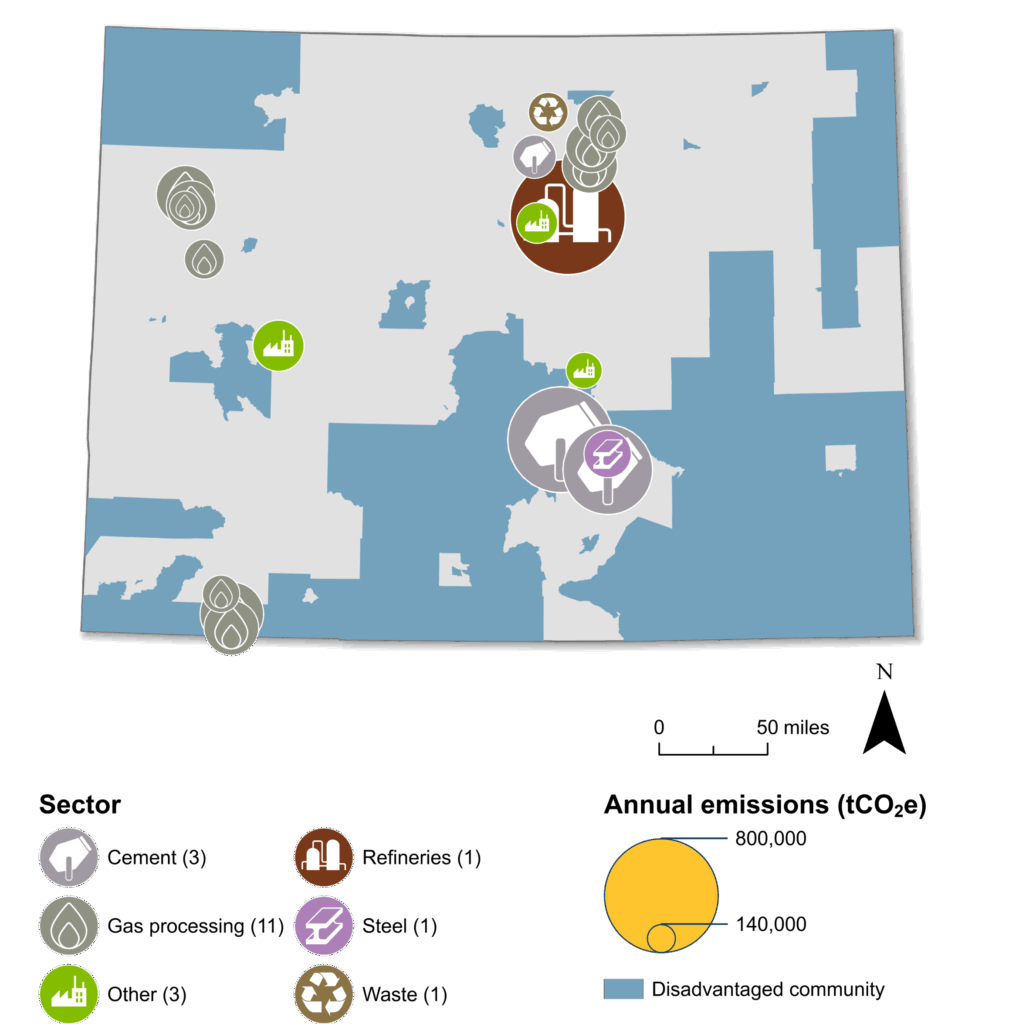Colorado
Petroleum and natural gas systems and mineral extraction are the largest-emitting sectors in Colorado. Refineries and waste are also significant emitters. Industrial facilities are primarily concentrated in the state’s northern tier. There are also notable concentrations of industry in the Pueblo and Durango areas.

- The top 20 emitters are shown on this map, coded by industrial sector. The size of the circles corresponds to emissions: the larger the circle, the higher the emissions.
- Disadvantaged communities (as determined by the federal government) are shaded blue.

- The inner circle provides a visual representation of the share of emissions generated by each industrial sector.
- The outer circle also indicates the share of a sector’s emissions generated in disadvantaged communities.
STATE ENERGY POLICY:
Examining a state’s broader energy policy landscape is helpful when considering policies to support industrial innovation. Colorado has established a greenhouse gas emissions target and, in 2004, was the first state to set a renewable portfolio standard by ballot initiative. In 2021, Colorado was also among the first states to establish a clean heat standard. While these formal commitments are not prerequisites for innovative industrial policy, they can provide a supportive framework. In addition, streamlining permitting and establishing an efficient, transparent appeals process that engages local communities early while giving clarity and assurances to project developers are key components of effective state energy policy. Discussions around innovative industrial policy present an opportunity for broader conversations about state energy policy to ensure a mutually reinforcing strategy.
LEGISLATIVE context & opportunity:
Let us know if you are aware of additional legislation advancing industrial innovation in Colorado that should be featured. The context below is not exhaustive and serves as an example of recent policies and programs and where there may be future opportunities:
- Colorado Industrial Tax Credit Offering (CITCO): CITCO is a $168 million refundable tax credit program for industrial facilities that offers up to eight million per eligible project. The program is available until all tax credits are reserved or through 2032. Application cycles are open semi-annually (with an annual deadline of June 30 and December 31). Colorado recently completed a $25 million Clean Air Program that provided grants to industrial facilities for reducing air pollution.
- Buy Clean Colorado Act: Colorado was the second state to pass a Buy Clean policy in 2021 with H.B. 21-1303. The Buy Clean Colorado Act requires the establishment of a maximum acceptable global warming potential limit for asphalt and asphalt mixtures, cement and concrete mixtures, glass, post-tension steel, reinforcing steel, structural steel, and wood structural elements.
- Carbon management technologies are another opportunity to reduce industrial emissions in the state. Learn more about the economically feasible subsectors in Colorado and facilities that qualify for the federal 45Q tax credit.
- A factsheet by the Renewable Thermal Collaborative identifies electrification of Colorado’s beer, container glass, and beet sugar subsectors as opportunities to reduce emissions significantly.
Colorado has enacted and considered a range of legislation that supports industrial modernization, including carbon capture, clean hydrogen, and procurement. Explore recent legislation in Colorado and all 50 states by clicking on a specific year: 2025 legislation, 2024 legislation, 2023 legislation.
